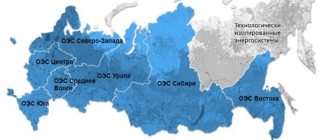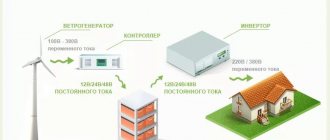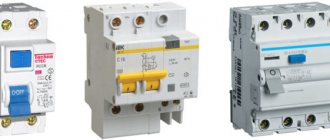Imagine, you and your child are getting ready to watch a cartoon or an educational program, lay down on the sofa, and suddenly your child asks: “What makes the TV/phone/tablet work?” It seems that the answer is simple - from electricity, but you don’t need to be Nostradamus to predict the next question that will come from a child: “Where does electricity come from?” And here many parents are stupefied, especially those who did not finish physics and mathematics, and their profession is in no way connected with this direction.
Of course, you can answer as simply as the previous question: “Electricity comes from the outlet.” But so that your child receives a complete and clear answer, in an accessible and understandable language, without abstruse formulas and definitions that most physics textbooks are written in, we suggest staying on this page and reading, perhaps not new, but useful and informative information.
What is electricity?
The word “electricity” itself, or more precisely, “electric” force, appeared more than 2000 years ago in Ancient Greece. People have noticed that if you rub amber on wool, the stone begins to attract various small objects. Amber in ancient Greek was called “electron”, hence the name itself.
But the study of the mysterious phenomenon did not progress beyond simple experiments with static electricity among the Ancient Greeks. And the essence of the whole phenomenon began to be revealed much later. Scientists have found that surrounding objects consist of elementary particles: protons and electrons. These two types of particles have an electric charge: the electron has a negative charge, but the proton has a positive charge. Attracted to each other, they closely interact and, depending on the number of protons and electrons, form atoms of different matters.
The protons themselves are located in the nucleus of the atom, but the electrons rotate around them in a circle. Atoms with the same number of protons as the number of electrons have zero charge. For example, if an amber stone lies on its own and no one touches it, then its atoms also have zero charge. But if you rub amber atoms against wool atoms, the electrons from the wool will instantly move to the amber ones, and their “excess” will make the charge negative. Such a pebble with “new strength” begins to attract small objects with a zero or positive charge, and if the object has a negative charge, it will repel them.
Electricity distribution
After the generation of electricity, the stage of its transmission and distribution begins, which is provided by energy supply companies. Resource suppliers organize the appropriate infrastructure, the basis of which is electrical networks. There are two types of channels through which electricity is transmitted - overhead and underground cable lines. These networks are the ultimate source and main answer to the question of where electricity comes from for various user needs. Supplier organizations lay special routes for organizing network distribution of electricity, using different types of cables.
Electric current is an organized group of electrons
But how does electricity live in an outlet if everything is so dispersed in this circuit?
Almost all atoms can lose and gain electrons. So, if some have an excess of them, and others have a deficiency, then the electrons directed by electrical forces will rush to where they are lacking. This flow is called electric current.
Among the concepts familiar to us, electric current is similar to a river, which, spilling into many branches, powers electrical appliances. But before sending this stream of negatively charged particles, do they need to be taken from somewhere?
The best minds of the last millennium struggled with this issue, but the first to make a breakthrough was the Italian scientist Alessandro Volta, who in 1800 invented the first battery, called the “Volta Pillar,” thereby giving the world a reliable source of constant electricity. In gratitude for such a discovery, the scientist’s name was immortalized, and since that time, current voltage has been measured in volts.
What does direct current mean?
Electric current is of two types: alternating and direct. They differ in that the latter does not change its direction, it has two clamps (positive “+” and negative “-”) and always begins its movement from “+”. And alternating current has two terminals - phase and zero. It is precisely because of the presence of one phase at the end of the conductor that it is also called single-phase.
The principles of the design of single-phase alternating and direct electric current are completely different: unlike constant, alternating current changes both its direction (forming a flow both from phase towards zero and from zero towards phase) and its magnitude. For example, alternating current periodically changes the value of its charge. It turns out that at a frequency of 50 Hz (50 vibrations per second), electrons change the direction of their movement exactly 100 times.
Where does electricity come from?
Despite the fact that the “Volta Pillar” made a breakthrough in the science of that time, over the next 200 years a lot of more global discoveries were made and many ways to produce electric current were discovered, for which huge structures were built and the latest technologies were used! And now, in order.
TPP - thermal power plant
To generate current, a turboelectric generator is installed at the thermal power plant, consisting of:
- the fixed part is a stator in the form of a bipolar magnet;
- a rotating rotor, which is wound with copper wire, since this metal is considered the best and most accessible conductor.
The continuous rotation of the magnet constantly changes the polarity (poles) causing the electrons in the wire to move, as in the example with amber and wool, only on a larger scale. But for this whole mechanism to work and electricity to be generated, “something” must spin a huge turbine. For this purpose, huge boilers are installed at thermal power plants that heat water to 450 ℃, causing it to turn into steam. Next, under high pressure, steam flows from the boiler onto the blades attached to the rotor, and starts it into operation at an incredible speed - 3000 revolutions per minute!
NPP - nuclear power plant
Here, just like in the thermal power plant, a turboelectric generator is installed, but the very dangerous, but energy-efficient Uranium-235 is responsible for heating the water. In order for it to release heat, huge nuclear reactors are built at nuclear power plants, in which Uranium-235 breaks down into small particles, which generates a large amount of energy used to heat water to steam and start a turboelectric generator.
HPP - hydroelectric power station
A safer, but no less effective way to obtain energy. Although it will require the construction of a whole chain of hydraulic structures in order to create the necessary water pressure to ensure the operation of the turbines of the electric generator. And then the principle is the same as in the previous two power plants: the rotor rotates and electricity is generated.
Wind stations
They look majestic and beautiful, and even in ancient times, with the help of the power of the wind, huge mechanisms such as windmills were put into operation.
In the modern world, they decided to improve this mechanism and use it to convert mechanical energy into electrical energy. The principle is as follows: the wind pushes huge blades, which put the generator rotor into operation, and it, as we know from the example of the first three power plants, produces current.
But in this way, with the help of one wind generator, you cannot provide even a small town with electricity, which is why a whole network of huge mechanisms, consisting of 100 or more units, is installed.
DC operation
What are its main characteristics? This is work and current power, and both of these concepts are very closely related to each other. Power refers to the speed of work per unit of time (per 1 s). According to the Joule-Lenz law, we find that the work done by a direct electric current is equal to the product of the strength of the current itself, the voltage and the time during which the work of the electric field was done to transfer charges along the conductor.
This is the formula for finding the work of current, taking into account Ohm’s law on resistance in conductors: A = I2*R*t (work is equal to the square of the current multiplied by the value of the resistance of the conductor and multiplied again by the time during which the work was done).
A little history
The world's first public power plant, Pearl Street, was built in New York in 1882. It was designed and installed by none other than Thomas Edison. And he didn’t even charge a fee for using the generated electricity until the entire mechanism worked smoothly and without interruptions.
But the “great-grandmother” of all stations could light only 10,000 lamps, although even at that time this was something supernatural. At the same time, modern power plants produce thousands of times more, providing electricity to cities with a population of 100,000 people!
Mysteries of nature: living electricity
Oksana Semyachkina-Glushkovskaya, Ph.D. biol. sciences
“Science and Life” No. 9, 2010
We continue to publish popular science lectures given by young university teachers who received grants from the V. Potanin Charitable Foundation. This time we present to our readers a summary of the lecture given by Associate Professor of the Department of Human and Animal Physiology at Saratov State University. N. G. Chernyshevsky Candidate of Biological Sciences Oksana Semyachkina-Glushkovskaya.
Living power plants
Electricity plays a sometimes invisible but vital role in the existence of many organisms, including humans.
Surprisingly, electricity entered our lives thanks to animals, in particular electric fish. For example, the electrophysiological direction in medicine is based on the use of electric stingrays in medical procedures. Living sources of electricity were first introduced into his medical practice by the famous ancient Roman physician Claudius Galen. The son of a wealthy architect, Galen received, along with a good education, an impressive inheritance, which allowed him to travel for several years along the shores of the Mediterranean Sea. One day, in one of the small villages, Galen saw a strange sight: two local residents were walking towards him with stingrays tied to their heads. This “painkiller” found use in treating the wounds of gladiators in Rome, where Galen returned after completing his journey. The peculiar physiotherapy procedures turned out to be so effective that even Emperor Mark Antony, who suffered from back pain, risked using an unusual method of treatment. Having gotten rid of a debilitating illness, the emperor appointed Galen as his personal physician.
However, many electric fish use electricity for far from peaceful purposes, in particular to kill their prey.
Monument to Luigi Galvani (1737–1798), an Italian physician and physiologist, in his hometown of Bologna. Photo by Vitaly Pirozhkov
For the first time, Europeans encountered monstrous living power plants in the jungles of South America. A party of adventurers who penetrated the upper reaches of the Amazon came across many small streams. But as soon as one of the expedition members stepped foot into the warm water of the stream, he fell unconscious and remained in this state for two days. It was all about the electric eels that live in these latitudes. Amazonian electric eels, reaching three meters in length, are capable of generating electricity with a voltage of more than 550 V. An electric shock in fresh water stuns prey, which usually consists of fish and frogs, but can also kill a person and even a horse if they are nearby at the moment of discharge eel
It is unknown when humanity would have seriously taken up electricity if not for an amazing incident that happened to the wife of the famous Bolognese professor Luigi Galvani. It's no secret that Italians are famous for their wide taste preferences. Therefore, they are not averse to sometimes playing with frog legs. The day was stormy and a strong wind was blowing. When Senora Galvani entered the butcher shop, a terrible picture was revealed to her eyes. The legs of the dead frogs, as if alive, twitched when they touched the iron railings with a strong gust of wind. The senora bothered her husband so much with her stories about the butcher’s proximity to evil spirits that the professor decided to find out for himself what was really going on.
This was that very happy occasion that immediately changed the life of the Italian anatomist and physiologist. Having brought home the frog's legs, Galvani became convinced of the veracity of his wife's words: they really twitched when they touched iron objects. At that time the professor was only 34 years old. He spent the next 25 years trying to find a reasonable explanation for this amazing phenomenon. The result of many years of work was the book “Treatises on the Power of Electricity in Muscular Movement,” which became a real bestseller and excited the minds of many researchers. For the first time they started talking about the fact that there is electricity in each of us and that it is the nerves that are a kind of “electrical wires”. It seemed to Galvani that the muscles accumulated electricity and, when contracted, emitted it. This hypothesis required further research. But political events associated with Napoleon Bonaparte's rise to power prevented the professor from completing his experiments. Due to his freethinking, Galvani was expelled from the university in dishonor and a year after these tragic events he died at the age of sixty-one.
And yet, fate wished that Galvani’s works would find their continuation. Galvani's compatriot Alessandro Volta, having read his book, came to the idea that chemical processes are the basis of living electricity, and created the prototype of the batteries we are familiar with.
Biochemistry of electricity
Two more centuries passed before humanity managed to uncover the secret of living electricity. Until the electron microscope was invented, scientists could not even imagine that there was a real “customs” around the cell with its own strict “passport control” rules. The membrane of an animal cell is a thin shell invisible to the naked eye, having semi-permeable properties, and is a reliable guarantor of preserving the viability of the cell (maintaining its homeostasis).
Electric eel is capable of generating electricity up to 550 V
But let's return to electricity. What is the relationship between the cell membrane and living electricity?
So, the first half of the 20th century, 1936. In England, zoologist John Young publishes a method for dissecting the nerve fiber of a cephalopod. The fiber diameter reached 1 mm. This “giant” nerve, visible to the eye, retained the ability to conduct electricity even outside the body in sea water. This is the “golden key” with the help of which the door to the secrets of living electricity will be opened. Only three years passed, and Jung’s compatriots, Professor Andrew Huxley and his student Alan Hodgkin, armed with electrodes, carried out a series of experiments on this nerve, the results of which changed the worldview and “lit the green light” on the path to electrophysiology.
The starting point for these studies was Galvani’s book, namely his description of the damage current: if a muscle is cut, then the electric current “pouring out” from it, which stimulates its contraction. In order to repeat these experiments on the nerve, Huxley pierced the membrane of the nerve cell with two hair-thin electrodes, thus placing them in its contents (cytoplasm). But bad luck! He was unable to register electrical signals. Then he took out the electrodes and placed them on the surface of the nerve. The results were sad: absolutely nothing. It seemed that fortune had turned away from the scientists. The last option remained - place one electrode inside the nerve and leave the other on its surface. And here it is, a happy occasion! After just 0.0003 seconds, an electrical impulse was recorded from a living cell. It was obvious that in such an instant the impulse could not arise again. This meant only one thing: the charge was concentrated on a resting, undamaged cell.
In subsequent years, similar experiments were carried out on countless other cells. It turned out that all cells are charged and that the charge of the membrane is an integral attribute of its life. As long as the cell is alive, it has a charge. However, it was still unclear how the cell is charged? Long before Huxley's experiments, the Russian physiologist N. A. Bernstein (1896–1966) published his book “Electrobiology” (1912). In it, like a seer, he theoretically revealed the main secret of living electricity - the biochemical mechanisms of the formation of a cell charge. Surprisingly, a few years later this hypothesis was brilliantly confirmed in Huxley’s experiments, for which he was awarded the Nobel Prize. So what are these mechanisms?
As you know, everything ingenious is simple. This turned out to be the case in this case as well. Our body consists of 70% water, or rather, a solution of salts and proteins. If you look inside the cell, you will find that its contents are oversaturated with K+ ions (there are about 50 times more of them inside than outside). Between cells, in the intercellular space, Na+ ions predominate (there are about 20 times more of them than in the cell). Such disequilibrium is actively maintained by the membrane, which, like a regulator, allows some ions to pass through its “gate” and does not allow others to pass through.
The membrane, like a sponge cake, consists of two loose layers of phospholipids, the thickness of which is penetrated by proteins. Image: Science and Life
The membrane, like a sponge cake, consists of two loose layers of complex fats (phospholipids), the thickness of which is penetrated like beads by proteins that perform a wide variety of functions, in particular they can serve as a kind of “gate” or channels. These proteins have holes inside them that can open and close using special mechanisms. Each type of ion has its own channels. For example, the movement of K+ ions is possible only through K+ channels, and Na+ - through Na+ channels.
When the cell is at rest, the green light is on for K+ ions and they freely leave the cell through their channels, heading to where there are few of them in order to balance their concentration. Remember your school experience in physics? If you take a glass of water and drop diluted potassium permanganate (potassium permanganate) into it, then after a while the molecules of the dye will evenly fill the entire volume of the glass, turning the water pink. A classic example of diffusion. This happens in a similar way with K+ ions, which are in excess in the cell and always have a free exit through the membrane. Na+ ions are like persona non grata
, do not have privileges from the resting cell membrane. At this moment, for them the membrane is like an impregnable fortress, which is almost impossible to penetrate, since all Na+ channels are closed.
But what does electricity have to do with it, you say? The thing is that, as noted above, our body consists of dissolved salts and proteins. In this case we are talking about salts. What is dissolved salt? This is a duo of interconnected positive cations and negative acid anions. For example, a solution of potassium chloride is K+ and Cl–, etc. By the way, saline solution, which is widely used in medicine for intravenous infusions, is a solution of sodium chloride - NaCl (table salt) at a concentration of 0.9%.
Under natural conditions, K+ or Na+ ions simply do not exist alone; they are always found with acid anions - SO42–, Cl–, PO43–, etc., and under normal conditions the membrane is impermeable to negative particles. This means that when K+ ions move through their channels, the anions associated with them, like magnets, are drawn behind them, but, unable to get out, accumulate on the inner surface of the membrane. Since Na+ ions, that is, positively charged particles, predominate outside the cell, in the intercellular space, plus K+ ions constantly seep into them, an excess positive charge is concentrated on the outer surface of the membrane, and a negative one on its inner surface. So a cell at rest “artificially” restrains the imbalance of two important ions - K+ and Na+, due to which the membrane is polarized due to the difference in charges on both sides. The cell's resting state charge is called the resting membrane potential, which is approximately -70 mV. It was this magnitude of charge that was first recorded by Huxley on the giant nerve of a mollusk.
The Na/K-ATPase enzyme works on a shuttle principle, pumping three Na ions out of the cell and pumping in two K ions to restore functionality. Image: Science and Life
When it became clear where the “electricity” comes from in a cell at rest, the question immediately arose: where does it go if the cell is working, for example, when our muscles contract? The truth lay on the surface. It was enough to look inside the cell at the moment of its excitement. When a cell reacts to external or internal influences, at that moment all Na+ channels open with lightning speed, as if on command, and Na+ ions, like a snowball, rush into the cell in a fraction of a second. Thus, in an instant, in a state of cell excitation, Na+ ions balance their concentration on both sides of the membrane, K+ ions still slowly leave the cell. The release of K+ ions is so slow that when the Na+ ion finally breaks through the impenetrable walls of the membrane, there are still quite a lot of them left there. Now, inside the cell, namely on the inner surface of the membrane, an excess positive charge will be concentrated. On its outer surface there will be a negative charge, because, as in the case of K+, a whole army of negative anions will rush behind Na+, for which the membrane is still impermeable. Held on its outer surface by electrostatic forces of attraction, these “fragments” of salts will create a negative electric field here. This means that at the moment of cell excitation we will observe a charge reversal, that is, a change in its sign to the opposite one. This explains why the charge changes from negative to positive when a cell is excited.
There is another important point that Galvani described in ancient times, but could not correctly explain. When Galvani damaged a muscle, it contracted. Then it seemed to him that this was a current of damage and it was “pouring out” from the muscle. To some extent, his words were prophetic. The cell actually loses its charge when it works. Charge exists only when there is a difference between the concentrations of Na+/K+ ions. When the cell is excited, the number of Na+ ions on both sides of the membrane is the same, and K+ tends to the same state. That is why when the cell is excited, the charge decreases and becomes equal to +40 mV.
When the riddle of “excitation” was solved, another question inevitably arose: how does the cell return to normal? How does the charge appear on it again? After all, she doesn’t die after working. And indeed, a few years later they found this mechanism. It turned out to be a protein embedded in the membrane, but it was an unusual protein. On the one hand, it looked the same as channel squirrels. On the other hand, unlike its brothers, this protein “charged dearly for its work,” namely energy, so valuable for the cell. Moreover, the energy suitable for its operation must be special, in the form of ATP (adenosine triphosphoric acid) molecules. These molecules are specially synthesized at the “energy stations” of the cell - mitochondria, carefully stored there and, if necessary, delivered to their destination with the help of special carriers. The energy from these “warheads” is released during their disintegration and is spent on various needs of the cell. In particular, in our case, this energy is required for the work of a protein called Na/K-ATPase, the main function of which is to transport Na+ out of the cell, like a shuttle, and K+ in the opposite direction.
Thus, in order to restore lost strength, you need to work. Think about it, there is a real paradox hidden here. When a cell works, this process occurs passively at the level of the cell membrane, and in order to rest, it requires energy.
How nerves “talk” to each other
If you prick your finger, your hand will immediately withdraw. That is, with a mechanical effect on skin receptors, the excitation that arises at a given local point reaches the brain and returns back to the periphery so that we can adequately respond to the situation. This is an example of an innate response, or unconditioned reflexes, which includes many defensive responses such as blinking, coughing, sneezing, scratching, etc.
How can excitation, having arisen on the membrane of one cell, be able to move on? Before answering this question, let's get acquainted with the structure of a nerve cell - a neuron, the meaning of “life” of which is to conduct excitation or nerve impulses.
So, a neuron, like a flying comet, consists of a nerve cell body, around which there are many small processes - dendrites, and a long “tail” - an axon. It is these processes that serve as a kind of wires through which “living current” flows. Since this entire complex structure is a single cell, the processes of a neuron have the same set of ions as its body. What is the process of excitation of a local region of a neuron? This is a kind of disturbance of the “calmness” of its external and internal environment, expressed in the form of directed movement of ions. Excitation, having arisen in the place where the stimulus occurred, spreads further along the chain according to the same principles as in this area. Only now the stimulus for neighboring areas will not be an external stimulus, but internal processes caused by the flow of Na+ and K+ ions and changes in the membrane charge. This process is similar to how waves propagate from a pebble thrown into water. Just as in the case of a pebble, biocurrents along the nerve fiber membrane spread in circular waves, causing excitation of increasingly distant areas.
In the experiment, excitation from a local point propagates further in both directions. In real conditions, nerve impulses are carried out unidirectionally. This is due to the fact that the area that has been worked needs rest. And the rest of a nerve cell, as we already know, is active and associated with energy expenditure. Excitation of a cell is the “loss” of its charge. That is why, as soon as a cell works, its ability to excite drops sharply. This period is called refractory, from the French word refractaire.
- unresponsive. Such immunity can be absolute (immediately after excitation) or relative (as the membrane charge is restored), when it is possible to cause a response, but by excessively strong stimuli.
If you ask yourself what color our brain is, it turns out that the vast majority of it, with a few exceptions, is gray and white. The bodies and short processes of nerve cells are gray, and the long processes are white. They are white because there is additional insulation on top of them in the form of “fat” or myelin pads. Where do these pillows come from? Around the neuron there are special cells named after the German neurophysiologist who first described them - Schwann cells. They, like nannies, help the neuron grow and, in particular, secrete myelin, which is a kind of “fat” or lipid, which carefully wraps the areas of the growing neuron. However, this outfit does not cover the entire surface of the long process, but separate areas, between which the axon remains bare. The exposed areas are called nodes of Ranvier.
It’s interesting, but the speed of excitation depends on how the nerve process is “dressed.” It’s not hard to guess - a special “uniform” exists in order to increase the efficiency of the passage of biocurrents along the nerve. Indeed, if in gray dendrites the excitation moves like a turtle (from 0.5 to 3 m/s), sequentially, without missing a single section, then in the white axon nerve impulses jump along the “bare” areas of Ranvier, which significantly increases the speed of their conduction up to 120 m/s. Such fast nerves innervate mainly the muscles, providing protection to the body. Internal organs do not need such speed. For example, the bladder can stretch for a long time and send impulses about its fullness, while the hand must immediately withdraw from the fire, otherwise it threatens damage.
The adult brain weighs on average 1300 g. This mass is made up of 1010 nerve cells. Such a huge number of neurons! By what mechanisms does excitation travel from one cell to another?
Unraveling the mystery of communication in the nervous system has its own history. In the mid-19th century, French physiologist Claude Bernard received a valuable parcel from South America containing curare poison, the same poison that the Indians used to smear their arrowheads. The scientist was keen on studying the effects of poisons on the body. It was known that an animal struck by such a poison dies from suffocation due to paralysis of the respiratory muscles, but no one knew exactly how the lightning-fast killer worked. In order to understand this, Bernard performed a simple experiment. He dissolved the poison in a Petri dish, placed a muscle with a nerve there and saw that if only the nerve is immersed in the poison, the muscle remains healthy and can still work. If you poison only a muscle with poison, then even in this case its ability to contract is preserved. And only when the area between the nerve and the muscle was placed in the poison, a typical picture of poisoning could be observed: the muscle became unable to contract even under very strong electrical influences. It became obvious that there was a “gap” between the nerve and the muscle, which is where the poison acts.
Micrograph of a neuron densely packed with synapses
It turned out that such “gaps” can be found anywhere in the body; the entire neural network is literally permeated with them. Other substances were also found, such as nicotine, which selectively acted on the mysterious places between the nerve and the muscle, causing it to contract. At first, these invisible connections were called the myoneural connection, and later the English neurophysiologist Charles Sherrington gave them the name synapses, from the Latin word synapsis
- connection, connection.
However, the final point in this story was put by the Austrian pharmacologist Otto Lewy, who managed to find an intermediary between nerve and muscle. They say that he dreamed that a certain substance was “pouring out” from the nerve and causing the muscle to work. The next morning, he firmly decided: he needed to look for this particular substance. And he found it! Everything turned out to be quite simple. Levi took two hearts and isolated the largest nerve on one of them - nervus vagus
. Foreseeing in advance that something would stand out from it, he connected these two “muscle motors” with a system of tubes and began to irritate the nerve. Levi knew that his irritation made his heart stop. However, not only the heart on which the irritated nerve acted stopped, but also the second one connected to it by the solution. A little later, Levi managed to isolate this substance in its pure form, which was called “acetylcholine”. Thus, irrefutable evidence was found of the presence of an intermediary in the “conversation” between nerve and muscle. This discovery was awarded the Nobel Prize.
And then everything went much faster. It turned out that the principle of communication between nerves and muscles discovered by Levy is universal. With the help of such a system, not only nerves and muscles communicate, but also the nerves themselves communicate with each other. However, despite the fact that the principle of such communication is the same, intermediaries, or, as they were later called, mediators (from the Latin word mediator
- intermediary), may be different. Each nerve has its own, like a pass. This pattern was established by the English pharmacologist Henry Dale, for which he was also awarded the Nobel Prize. So, the language of neural communication became clear; all that remained was to see what this design looked like.
How does a synapse work?
If we look at a neuron through an electron microscope, we will see that it is like a Christmas tree, all hung with some kind of buttons. There can be up to 10,000 such “buttons”, or, as you may have guessed, synapses on just one neuron. Let’s take a closer look at one of them. What will we see? At the terminal portion of the neuron, the long process thickens, so it appears to us in the form of a button. In this thickening, the axon seems to become thinner and loses its white coat in the form of myelin. Inside the “button” there is a huge number of bubbles filled with some substance. In 1954, George Palade guessed that this was nothing more than a storage facility for mediators (20 years later he was given the Nobel Prize for this guess). When the excitation reaches the end station of the long process, the mediators are released from their confinement. Ca2+ ions are used for this. Moving towards the membrane, they merge with it, then burst (exocytosis), and the transmitter under pressure enters the space between the two nerve cells, which is called the synaptic cleft. It is negligible, so the molecules of the mediator quickly reach the membrane of the neighboring neuron, which in turn contains special antennas, or receptors (from the Latin word recipio - to take, accept), which capture the mediator. This happens according to the principle of “key to lock” - the geometric shape of the receptor completely corresponds to the shape of the mediator. Having exchanged a “handshake”, the mediator and receptor are forced to part. Their meeting is very short and the last for the mediator. Just a split second is enough for the transmitter to trigger excitation on a neighboring neuron, after which it is destroyed using special mechanisms. And then this story will repeat itself again and again, and so living electricity will run ad infinitum along the “nerve wires,” hiding many secrets from us and thereby attracting us with its mystery.
Is it necessary to talk about the significance of discoveries in the field of electrophysiology? Suffice it to say that seven Nobel Prizes were awarded for lifting the curtain on the world of living electricity. Today, the lion's share of the pharmaceutical industry is built on these fundamental discoveries. For example, now going to the dentist is not such a terrible ordeal. One injection of lidocaine - and the Na+ channels at the injection site will be temporarily blocked. And you will no longer feel painful procedures. You have a stomach ache, the doctor will prescribe medications (no-spa, papaverine, platifilin, etc.), the basis of which is the blockade of receptors so that the mediator acetylcholine, which triggers many processes in the gastrointestinal tract, cannot contact them, and etc. Recently, a series of centrally acting pharmacological drugs aimed at improving memory, speech function and mental activity have been actively developing.
How does electric current enter homes?
After power plants generate current, it travels through a cable to a distribution substation for measurement and conversion. Transformers installed there increase the voltage to 10,000 volts. Thanks to this voltage, current is transmitted over long distances with minimal losses at an incredible speed of up to 3000 km per second!
Then the current flows to a step-down substation, where transformers reduce the voltage to 220 volts - the standard adopted in the Russian Federation. And then the electricity is sent to the city’s distribution networks, and from there to your house and apartment. This is the difficult path he takes to charge our phone, light a light bulb or make the refrigerator work.
Why extract electricity from the ground?
In order to generate electricity, you need to find a potential difference and a conductor.
By connecting everything into a single flow, you can provide yourself with a constant source of electricity. However, in reality, taming the potential difference is not so simple. Nature conducts enormous power of electricity through a liquid medium. These are lightning discharges, which are known to occur in air saturated with moisture. However, these are just single discharges, and not a constant flow of electricity.
Man took on the function of natural power and organized the movement of electricity through wires. However, this is just a transfer of one type of energy to another. Extracting electricity directly from the environment remains mainly at the level of scientific research, experiments in the category of entertaining physics and the creation of small low-power installations.
The easiest way to extract electricity is from a solid and moist environment.
How does current make electrical appliances work?
But how does current manage to power electrical devices? For a visual understanding, let's take a regular incandescent lamp as a basis and return to our small particles.
As electrons travel at incredible speeds through the light bulb's spiral, they continually collide with the metal atoms that make up the spiral. The atoms wobble and their temperature rises greatly. Thus, the electric current heats the lamp spiral to 3000 degrees, causing it to begin to glow. This is why the use of any metal is not suitable for the spiral, because it will simply melt due to the high temperature.
Modern devices - mobile phones, TVs, microwave ovens - use more complex circuits, but the principle remains the same: due to the rapid flow of particles, the atoms of the conductors heat up, which releases energy and starts the devices to work.
Management of electric power facilities
In addition to the organization of the electrical grid, which technically provides the possibility of transmitting and distributing energy to end consumers, the operation of this complex is impossible without control systems. To implement these tasks, suppliers use operational control centers, whose employees implement centralized control and management of the work of the electric power facilities entrusted to them. In particular, such services control the parameters of networks to which electricity consumers are connected at different levels. Separately, it is worth noting the control center departments that perform network maintenance, preventing wear and tear and repairing damage in individual sections of lines.
Not only a friend, but also an enemy!
Of course, electricity is an important and irreplaceable invention for all mankind. With its help people:
- they have made and are making a lot of discoveries every day;
- treat diseases that were fatal in the past;
- drive electric vehicles without polluting the environment with exhaust gases;
- can travel the world, learn and see sights without leaving home!
All the benefits of electricity simply cannot be described in one article!
But with all this, the current can be dangerous and in a split second take the life of any living creature.
By the way, an interesting fact. Birds that sit on high-voltage wires do not receive a shock due to the fact that they receive the same voltage as in the cable itself. The fact is that they sit only on one phase, but if suddenly the bird’s tail or other part of the body touches the ground, a pole or another wire, the current will immediately hit it.
Traditional power plants
Although energy trends have changed rapidly in recent years, it is possible to identify the main types of power plants operating according to classical principles. First of all, these are thermal generation facilities. The resource is produced as a result of the combustion of organic fuel and the subsequent conversion of the released thermal energy. At the same time, there are different types of such stations, including heating and condensing. The main difference between them is the ability of objects of the second type to also generate heat flows. That is, when answering the question of where electricity comes from, we can also note stations that simultaneously produce other types of energy. In addition to thermal generation facilities, hydro and nuclear power plants are quite common. In the first case, it is assumed that energy will be converted from the movement of water, and in the second, as a result of the fission of atoms in special reactors.
Rules for safe handling of electricity for children
Young children do not understand the dangers of handling electricity. Of course, we are now not talking about toys powered by 12-volt batteries, but about a dangerous and powerful “beast” that lives in sockets. Therefore, children should not be left near sockets without special plugs, and even without parental supervision.
For older children, it is worth having a conversation and explaining the following rules. It is forbidden:
- Place or hang foreign objects on the device cable.
- Twist the cable into knots.
- Use dirty wire.
- Use an electrical appliance near heat sources: radiators, stoves, ovens, etc.
- Plug several powerful devices into one outlet at the same time. Show your child where and how you can see the power, or make a list in advance of what you can turn on and what you can’t.
- Use or try to repair a broken electrical appliance, including if the insulation (integrity) of the cable is broken, the plug is damaged, etc.
- Handle the device or cable with wet hands.
- Pull the cord (you need to unplug the device from the outlet while holding the plug).
Unforeseen situations may also arise:
- sparks from the socket;
- smoke from a cable or device;
- burning smell, etc.
In this case, it is necessary to show the child where the electrical panel is and how to turn it off, and explain that after a power outage it is necessary to call one of the adults.
Alternative energy sources
This category of energy sources usually includes solar rays, wind, subsoil, etc. Various generators focused on accumulating and converting solar energy into electricity are especially common. Such installations are attractive because they can be used by any consumer in the volumes required to supply his home. However, the wide distribution of such generators is hampered by the high cost of the equipment, as well as operational nuances caused by the dependence of working photocells on light intensity.
At the level of large energy companies, wind alternative sources of electricity are actively developing. Already today, a number of countries are using programs for a gradual transition to this type of energy supply. However, this direction also has its obstacles, due to the low power of generators and high cost. A relatively new alternative source of energy is the natural heat of the Earth. In this case, the stations convert thermal energy obtained from the depths of underground channels.
Method 2 - Zinc and copper electrode
The next method of generating electricity is based on using only land. Two metal rods are taken - one zinc, the other copper, and placed in the ground. It is better if it is soil in an isolated space.
Isolation is necessary in order to create an environment with high salinity, which is incompatible with life - nothing will grow in such soil. The rods will create a potential difference, and the soil will become an electrolyte.
In the simplest version, we get a voltage of 3 V. This, of course, is not enough for a home, but the system can be complicated, thereby increasing the power.











